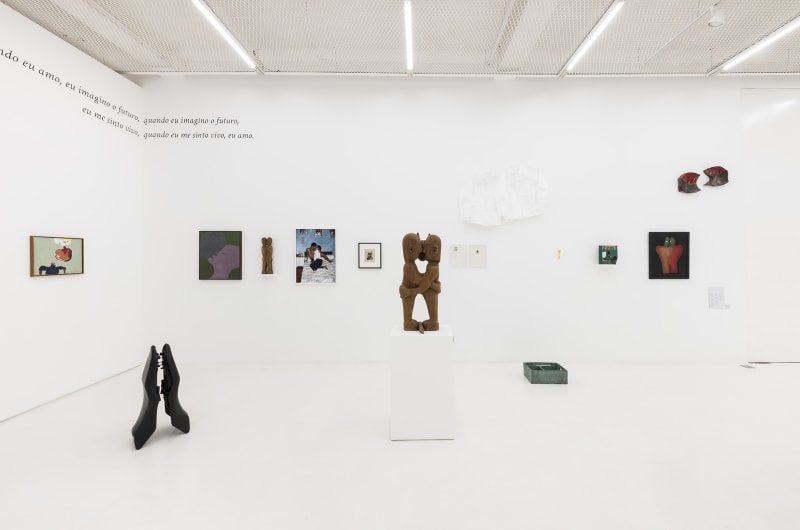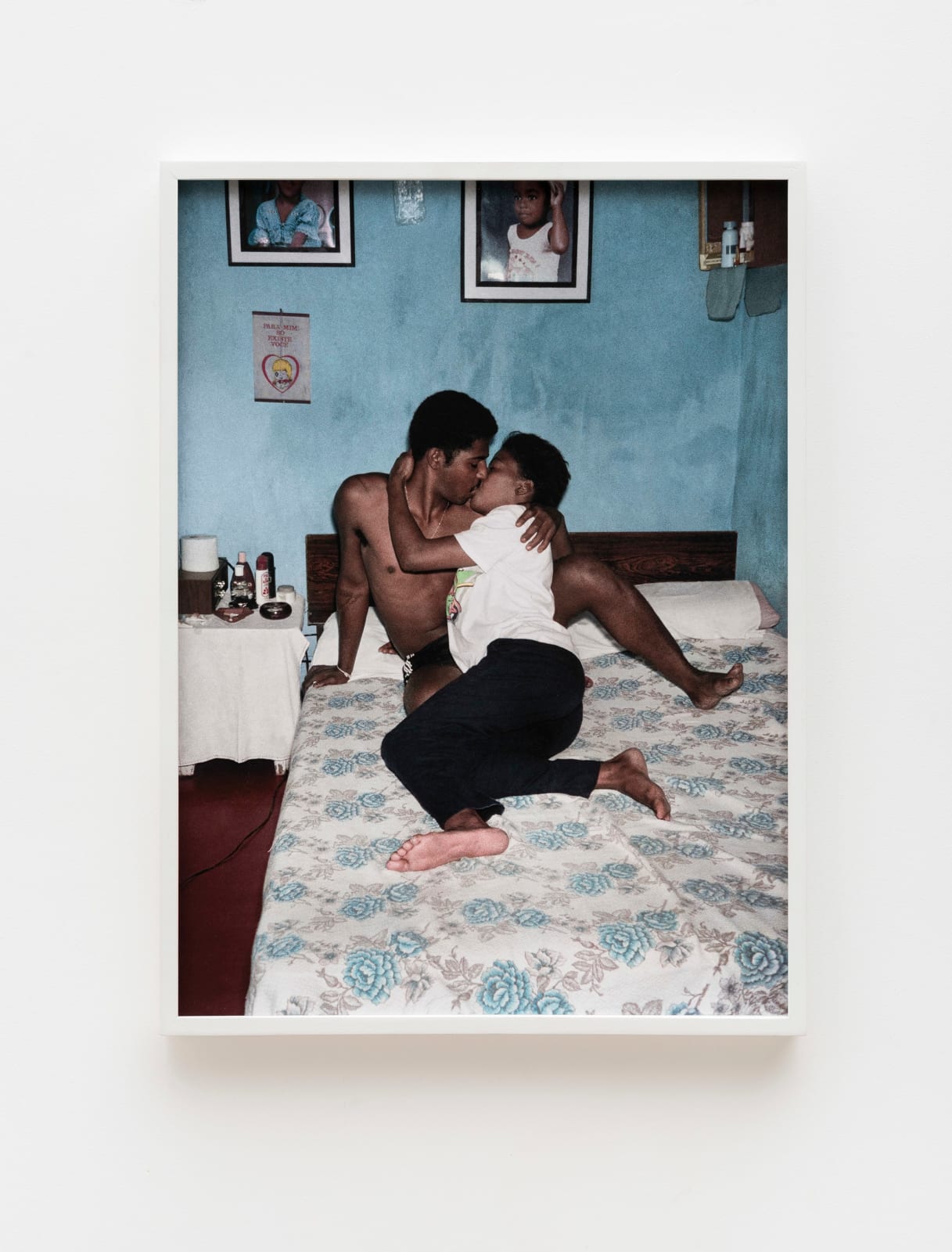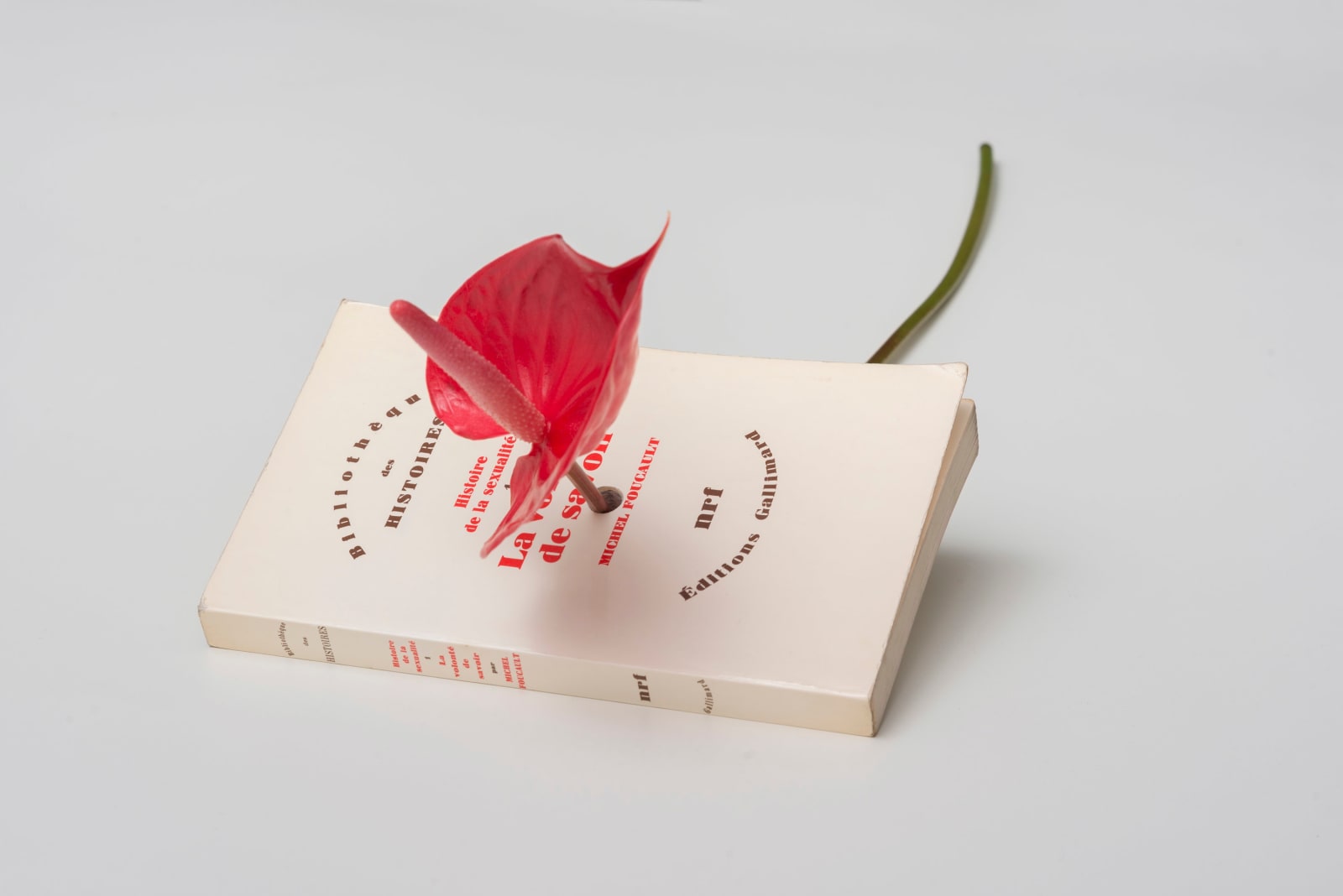Smoldering coals: Curated by: Tomás Toledo
I know, the scars speak
and the words silence
what I haven’t forgotten[1]
The desire to create this exhibition arose from my affection for the song Fera ferida [Wounded Beast] by Roberto Carlos, especially the stanza I use as the epigraph to this text, which has always reminded me of the enigmatic and indelible nature of passion and desire, and also of its language, which communicates more through the body than through words—something unspeakable that runs through the body like electricity and attracts (or repels) other bodies in a magnetic way. Such drives of desire and passion, as well as the marks and incandescence created by love, are the subject of this exhibition.
Smoldering Coals brings together more than 50 artists, mixing generations, territorialities, production contexts, genders and sexualities, and includes works in different media, such as painting, drawing, printmaking, photography, video and sculpture, as well as documentary material.
Three sections make up the exhibition: Entanglements, Metaphors of Sex and Metaphors of Love. The works presented explore the proximity between bodies, the tension of eroticism, the magnetism of desire and multiple representations of couples, as well as the metaphorical and poetic elaborations of love and the sometimes more ciphered and other times more explicit expressions of sex.
In the first room, in the Entanglements section, works are presented that show approximations, interlaces and tensions between bodies, sometimes figuratively and sometimes metaphorically, both in romantic scenes and in erotic compositions.
The section’s theme is divided into other three sections, the first of which is a large wall with a composition of works that show representations of couples or pairs in which there is a bodily closeness. The sequence begins in a more romantic way, with a gouache by Ismael Nery, in which we see a couple looking at each other, their bodies almost merging. Next to it is a mysterious painting by Oswald de Andrade Filho, showing two women wearing gloves, also looking at each other and merging their bodies. The woman on the left offers an apple to the other, creating a scene that could suggest a biblical interpretation, in a possible reference to the Old Testament passage in which Eve offers an apple to Adam, but here without the presence of the male figure.
Following the order of what is presented on the wall, we have a composition of works in which the theme of body bonding is developed through different approaches and techniques: Mayara Ferrão’s photography made by artificial intelligence, Hudinilson Jr.’s woodcuts, Nery, Yan Nicolas and Carlos Mota’s drawings, Louco’s wood sculpture and Victor Arruda and Siron Franco’s paintings. Siron’s canvas is a representation of a couple in bed, in a total fusion of bodies, concluding the enunciation of bodily involvement seen in Nery’s initial gouache.
In the second section of Entanglements, we have a group of works with romantic kissing scenes, including photos by the Retratistas do Morro collective and Mayara Ferrão, paintings by Farnese de Andrade and sculptures by João da Lagoa, Chico Tabibuia and Allan Weber. The figurative representation is dissolved in the following sequence of works, which expands the notion of the couple and makes use of metaphorical and conceptual presentations, as in the pairs of shirts by Rafael Amorim and the Gillette razors by Marcos Chaves (both referring to marriage in their titles), in the drawings of Leonilson’s Os dedicados [The Dedicated] series, in Julio Callado’s ménage of flip-flops, in Antonio Dias’ love triangle, in Luiz Roque’s heads, in Edgar de Souza’s balls, in Jonathas de Andrade’s “2 in 1” and “double”, and in the sexual tension of Alair Gomes’ photographs.
In the second section of the show, Metaphors of Sex, there are two walls with works that mix representations of phalluses and vulvas with works that approach sexuality in a metaphorical way.
In Vontade de saber [Will to Know], Thiago Honório pierces volume 1 of Michel Foucault’s History of Sexuality and passes through the hole the stem of an anthurium, a flower with a sexual character, since its morphology contains shapes that refer to both the phallus and the vulva. Around this work, we have a drawing by Moacir depicting a winged, naked trans figure, a painting by Fefa Lins, in which we see a person whose face is out of the canvas domain, masturbating with a dildo and surrounded by a natural landscape, and, finally, a canvas by Décio Noviello with the silhouette of a couple in a scene of seduction.
Also in this section, Amélia Toledo’s work O sonho do executivo [The Executive’s Dream] provocatively explores the fantasies of a successful straight man in a composition of images alluding to money and women, culminating in an executive’s briefcase with panties inside. On the next wall, there are several works that allude to the vulva, such as drawings by Cildo Meireles, Wesley Duke Lee and Artur Barrio, as well as other works that deal with the subject in a more ciphered way, such as Gabriella Marinho’s conch-vulva and Dani Cavalieri’s abstract drawings resulted from the gestures of masturbation. Next to the vulvas, a drawing by Tunga shows a naked body with three legs and two sexes, creating an interesting relationship with a sculpture by Chico Tabibuia that represents an Exu with the same characteristics as the figure imagined by Tunga. Alongside this duo is a sequence of works that represent or allude to the phallus, with photographs by Bauer Sá and Robert Mapplethorpe, sculptures by Chico Tabibuia and a notebook of drawings by Hudinilson Jr.
Finally, the third section, Metaphors of Love, displays works with metaphorical and textual representations of love. On one wall, there are three works on which the image of a heart or the word “amor” [love] are inscribed. Rosangela Rennó’s photograph, from the Cicatrizes [Scars] series, shows a man’s chest with the word “amor” [love] tattooed on it. Dora Longo Bahia, on the other hand, writes “amor” [love] and “ódio” [hate] with pins on leather canvases, creating an image reminiscent of a tattoo. And, finally, a bronze by Panmela Castro, in which the artist reproduces the bark of a tree, carved with the words: Autoestima e lucidez [Self-esteem and lucidity.] In Katie van Scherpenberg’s painting, a background that resembles lined paper has the space between the lines taken up by scribbles, and within this tangle of lines appears the word “amor” [love]. Opposite these three works is an object by Pablo Accinelli titled Destino común [Common Destiny], which consists of a cardboard box locked by four padlocks, with a four-leaf clover decorating its lid. The work makes us think of something very precious that needs to be taken care of and guarded, just like a love relationship.
In another part of the third section, we have a set of representations of the heart, the most well-known and widespread metaphor for love, which appears in a more stylized form in the works of Vilma Pasqualini, Farnese de Andrade and Rochelle Costi, or in more realistic representations, such as in the photography of Gabriella Marinho and the painting of Ramon Salles.
Memories of love are explored in two works by Rafael RG, in which the ideas of love and freedom are articulated through installation works that make use of documentary and textual material. The reminiscences of love are explored by Sérgio Gurgel in a video that brings together accounts of the love lives of two praying ladies from the Sertão Central [Central hinterland] region of Ceará, where the artist was born.
*
The title of the exhibition, Smoldering Coals, was borrowed from a poem in the form of a list titled Coisas para o ninho [Things for the nest], written by Patrícia Galvão (Pagú) in 1939, while she was imprisoned by the Getúlio Vargas dictatorship in the House of Detention in Rio de Janeiro, the manuscript of which is on display in the exhibition.
Things for the nest[2]
A large blanket
3 large white bedspreads
6 sheets
8 pillowcases
4 bath towels (I have two)
6 face towels
3 pyjamas for G.
3 pyjamas for Pat
3 sweaters for Pat
(Lots of kisses on the last half dozen)
Smoldering coals, remaining
TOMÁS TOLEDO is a curator and founding partner of Galatea.



![Amelia Toledo, O sonho do executivo [The Executive’s Dream], 1971-2005](https://artlogic-res.cloudinary.com/w_1600,h_1600,c_limit,f_auto,fl_lossy,q_auto/artlogicstorage/antoniabergamin/images/view/52f7d15692427bb46fee550a2a07c838j/galatea-amelia-toledo-o-sonho-do-executivo-the-executive-s-dream-1971-2005.jpg)

![Vilma Pasqualini, Sem título [Untitled], 1968](https://artlogic-res.cloudinary.com/w_1600,h_1600,c_limit,f_auto,fl_lossy,q_auto/artlogicstorage/antoniabergamin/images/view/fe211ca64674470337e2d2ca347905f7j/galatea-vilma-pasqualini-sem-t-tulo-untitled-1968.jpg)



